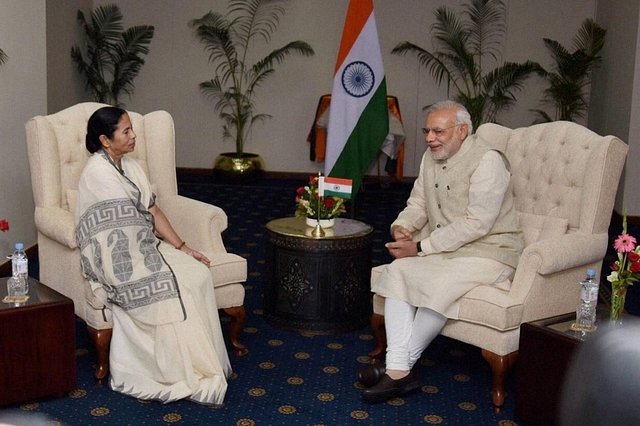
Unity Or Diversity? Modi Vs Mamata Exposes Faultlines In Hindu Political Assertiveness
The Hindu vote is torn between two types of loyalties, one representing the broader desire to unify Hindus across India, and another strain that wants to focus on the unique character of Bengali Hinduism.
As long as unity is seen as the enemy of diversity, Hindus will not be able to convert their numerical majority into a political majority.
The battle for West Bengal, being fought by two powerful political personalities, Narendra Modi and Mamata Banerjee, is essentially a battle for the Hindu vote. If we assume that few Muslims will vote for the Bharatiya Janata Party (BJP), the fight, which is getting intensely personal, is a fight for the bulk of the Hindu vote.
But here’s the crux: the Hindu vote is torn between two types of loyalties, one representing the broader desire to unify Hindus across India, and another strain that wants to focus on the unique character of Bengali Hinduism, as exemplified by the worship of Kali and Durga. The campaign tensions between Modi and Banerjee echo these contradictory Hindu aims – to find a broader unity across regions, and to preserve what is unique to local religious/cultural traditions.
In more reductionist terms, the battle for Bengal in 2019 is a battle between two slogans, Jai Shri Ram, which represents the broader aspirations for Hindu unity across India, and Jai Maa Kali, or Jai Maa Durga, slogans to assert regional pride in tradition.
The tension between two Hindu nationalisms in Bengal has parallels in how the Hindu north and south see their diversities and unity. In the south, which faced less Islamic depredation than the north, Hindus are confused by the northern obsession with the Ram Mandir, even though they have no objections to it.
On the other hand, the northern Hindu, traumatised by centuries of Islamist domination and repeated desecration and destruction of their holiest shrines (for details, read Meenakshi Jain’s book, Flight of Deities and Rebirth of Temples), simply does not understand the southern defence of Sabarimala, where tradition celebrates Swami Ayyappa as a naishtika brahmachari, an eternal celibate. Sabarimala does not allow women in the reproductive ages (10-50) to visit the sanctum sanctorum. The Rashtriya Swayamsevak Sangh or RSS, which represents the homogenising strain of northern Hinduism, was initially inclined to support the Supreme Court verdict of September 2018 which ended this restriction, but local political conditions in Kerala, where there was widespread Hindu outrage following this legal “desecration” of their hallowed traditions, forced it to change tack.
Similarly, cow protection is a big deal in the north rather than the south. Even though Hindus in the south share this sentiment and an overwhelming majority of them do not consume beef, they are not as squeamish about it as Hindi-belt Hindus.
The Bengal and Kerala religio-political fights, and differing attitudes to beef consumption in the north and south, suggest that there is a creative tension between the Hindu politics of the north as against the emerging Hindu politics of the east and south. The north would prefer to underline the unifying properties of less diversity, while the east and south want to preserve their own strong traditions.
This divergence in approaches is a product of history. North and south had differing recollections of Islamic rule. In the north, Islam made a violent entry after Muhammed bin Qasim conquered Sind in the eighth century CE, and then spread eastwards through conquests and war. Islam in the south came by way of trade, with West Asian traders reporting a presence in Kerala at a time pre-dating the Prophet. Religion followed trade.
Islamic invasions and subsequent rule were often characterised by extreme bigotry and the destruction of temple in the north. In the south, despite exceptional bigots like Tipu Sultan, or the campaigns of Malik Kafur, or the destruction of the Vijayanagar kingdom and heritage by a coalition of Deccan sultans, Muslim rule was not seen in too negative terms.
In fact, Hinduism in some of its more pristine forms has been better preserved in the south and parts of Maharashtra, with the Chola, Pandya, Pallava and Travancore kings playing protective roles, and some even taking the flag to south-east Asia. Krishnadeva Raya and Shivaji, among others, helped revive Hindu self-esteem in the buffer zones that separated the deep south from the Mughal empire.
This thumbnail history tells us why Hinduism and Hindu politics differ in the north and south, and to some extent in the east as well.
The future of Hindu political assertion on a national scale thus needs two kinds of deep dialogue: a north-south dialogue and a north-east one that finds common ground between the homogenising tendencies of the Sangh parivar and Hindutva leadership, and the diversity and autonomy desired by the east and south.
This is not a difficult task if both sides see the need for unity as much as diversity. Hindutva politics, instead of focusing on the “other”, would be more successful if it seeks to build a layer of common identity without trying to destroy the diversity that already exists within. As long as unity is seen as the enemy of diversity, Hindus will not be able to convert their numerical majority into a political majority. This is what the BJP needs to understand if it wants to expand in the east and south.